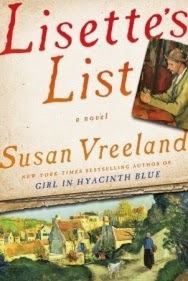Lisette's List
Summary (from the publisher): In 1937, young Lisette Roux and her husband, André, move from Paris to a village in Provence to care for André’s grandfather Pascal. Lisette regrets having to give up her dream of becoming a gallery apprentice and longs for the comforts and sophistication of Paris. But as she soon discovers, the hilltop town is rich with unexpected pleasures.
Pascal once worked in the nearby ochre mines and later became a pigment salesman and frame maker; while selling his pigments in Paris, he befriended Pissarro and Cézanne, some of whose paintings he received in trade for his frames. Pascal begins to tutor Lisette in both art and life, allowing her to see his small collection of paintings and the Provençal landscape itself in a new light. Inspired by Pascal’s advice to “Do the important things first,” Lisette begins a list of vows to herself (#4. Learn what makes a painting great). When war breaks out, André goes off to the front, but not before hiding Pascal’s paintings to keep them from the Nazis’ reach.
With German forces spreading across Europe, the sudden fall of Paris, and the rise of Vichy France, Lisette sets out to locate the paintings (#11. Find the paintings in my lifetime). Her search takes her through the stunning French countryside, where she befriends Marc and Bella Chagall, who are in hiding before their flight to America, and acquaints her with the land, her neighbors, and even herself in ways she never dreamed possible. Through joy and tragedy, occupation and liberation, small acts of kindness and great acts of courage, Lisette learns to forgive the past, to live robustly, and to love again.
Review: I received an advance uncorrected proof copy of this book as a giveaway on Goodreads.
This novel is about a young woman named Lisette, who moves from Paris to a small village in Provence right before the outbreak of World War II to care for her husband's ailing grandfather. Lisette and her husband are great art lovers, and Lisette longs to return to Paris, with dreams of working in a gallery. Fortunately, her grandfather-in-law is also an art-lover, and Lisette takes pleasure in hearing stories of how he acquired the collection of paintings in his home. However, Lisette's life takes a turn for the worse when war breaks out, her husband enlists, and the paintings disappear. In the aftermath of war, Lisette composes a list of goals to try to help her get her life back on track, while also beginning a search for the missing paintings.
This novel had a lot of potential. It was interesting that Lisette was raised in an orphanage. I also really like reading about the time period in which the novel was set and was curious to see what the experience of the French living not in Paris but in outlaying villages was like during the war. Art was another huge element of this novel, and I liked that the author weaves in real artists into the fictional storyline.
However, this novel failed to really capture my attention. With the exception of Lisette, nearly all of the characters are one dimensional, making it very difficult to feel connected to the story. For example, I would have loved to know more details about the nun who raised her and about her husband. Additionally, I found elements of the plot incredibly implausible. In particular, Lisette's treasure hunt for the paintings struck me as far fetched. It was difficult for me to believe that rolled up canvases would survive intact scattered throughout the village - in mines, tool sheds even in the dump. "It had been propped up in front of the handles of shovels and hoes, as if the farmer wanted to see it every time he opened the door" (346). I just didn't believe that 1) none of the paintings were damaged or ruined completely, 2) no one found them and sold them during the desperation of wartime, or 3) that Lisette would be able to find them all.
Finally, although I liked the theme of art (especially as Vreeland has excelled in the past by focusing on artists in her historical fiction), I found it a bit forced at times in this novel. When the narrative shifts to Pascal telling Lisette stories about how he came to own the paintings, it was difficult to follow who was speaking. The narrative shifted indecipherably between Lisette and Pascal, with ambiguous pronouns. It also felt as if the book was trying to give an art lesson at times, "Great art - painting, sculpture, and architecture - gives us something very rich. It allows us to experience times, places, emotions that we might not otherwise encounter. It invites us to ponder some item - a piece of fruit or a violin in the sky or a marble figure or a cathedral - until its qualities teach us something, or enrich us, or inspire us" (224).
I really enjoyed previous works by Vreeland, and love the unique historical subjects she chooses, however, this was not my favorite of her works.
Stars: 2



Comments
Post a Comment